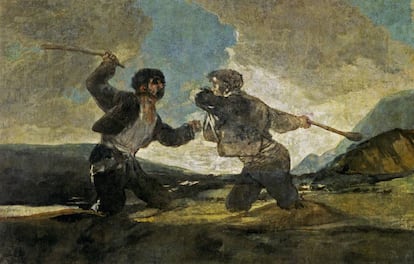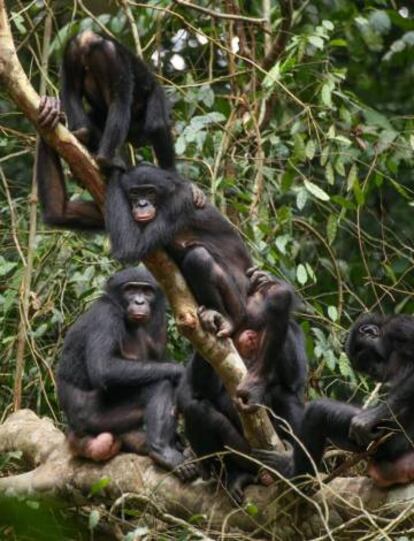Have we humans finally tamed our inner wolf?
Spanish study suggests ‘Homo sapiens’ kill one another less than evolution might dictate

When Thomas Hobbes coined the phrase: “Man is wolf to man” – “Homo homini lupus est” in Latin – in the mid-17th century, man was already more of a pet than a wolf to his fellows.
Many who still quote Hobbes perhaps don’t realize that chimpanzees are wolves to other chimpanzees, and even cute bug-eyed lemurs are likely to massacre their own kind under certain circumstances.
Violence has an evolutionary component but that doesn’t mean it’s determined by genetics José María Gómez, study author
In fact, the animal kingdom is rife with this kind of violence, which appears to be just another characteristic of evolution.
Within this context, just how lethal are humans to each other? A new study by Spanish scientists published in the latest edition of the science journal Nature compares our level of interpersonal violence with other mammals by drawing on a broad base of evidence.
According to the researchers, the proportion of human deaths predicted to be caused by interpersonal violence stands at 2%. In other words, two in every hundred deaths is the result of violence. Interestingly, the researchers point out that this figure corresponds to prehistoric rates of fatalities. After that, other factors come into play, first exacerbating and then mitigating our propensity for killing one another.
The authors of the study, from the Spanish National Research Council (CSIC) and the Universities of Granada and Rey Juan Carlos, spent two years compiling data based on their studies of 1,024 mammal species to quantify the level of intra-species lethal violence. They also gathered information on human carnage from 600 civilizations dating back 50,000 years.

They discovered that 4.5% of chimpanzees are killed by a fellow chimpanzee, while only 0.7% of bonobos are killed by their own kind. Meanwhile, violent deaths among humans in medieval times accounted for around 12% of the total.
The researchers established two factors that provoke greater levels of lethal violence within a species: their sociability and territoriality, both of which are human characteristics. Besides, our ancestral family tree can be traced back to the most bloody grand order of mammals called the euarchonta, which includes primates.
Meanwhile, the most violent behavior was found to occur among meerkats, mongooses, lions and other big cats, some lemurs and baboons, wolves and other canines that move in packs, as well as sea lions, groundhogs and prairie dogs.
“The 2% is more or less the percentage that corresponds to our phylogenetic roots,” says José María Gómez of Granada University. “But if that were our only influence, that 2% would not vary; there are cultural and contextual factors that manipulate the level of violence.”
From the Paleolithic period until the Bronze Age, levels of violence remained more or less constant. But when the Iron Age came around, the bloodletting among humans escalated until the modern age, when it started to correct itself. In the last two centuries, the proportion of lethally violent deaths is noticeably lower than in previous years, according to Gómez and his colleagues.
Being highly social and territorial sparks greater levels of violence
The researchers then went on to analyze the levels of violence in relation to the type of government in power. Prehistoric tribes moved within obvious boundaries. The rule of chieftains and ancient kings produced a dramatic rise in violence while the modern political state has managed to keep the levels well below the “expected” 2%.
“Our research can help to resolve the question of whether violence has an evolutionary component,” says Gómez, speaking from Spain’s Arid Zones Experimental Station. “But not whether there is a determining genetic element.”
Gómez explains that they look at political systems because they are an obvious potential influence but there are many other factors that can alter the level of lethal violence among humans such as culture and trade.
“Violence has an evolutionary component but that doesn’t mean it’s determined by genetics,” says Gómez
In recent years, the popular science author and psychologist Steven Pinker has become one of the most vocal and controversial figures on the subject after publishing books such as The Blank Slate and The Better Angels of our Nature, in which he argues that human violence has decreased over the course of history and that we are living in one of the least dangerous periods for our survival. When consulted about the Nature study, Pinker described himself as “impressed” with Gómez and his team. “If only this study had been done when I wrote the book,” he said.
“It’s a creative and meticulous analysis, and of course one that is consistent with my view of the history of violence, “ added Pinker, who points out that many animals, not just humans, kill one another, and the fact that we are social and territorial means that a high level of violence is to be expected, although we have learned how to correct it by establishing laws and institutions.
“Although I pointed all this out in The Better Angels of our Nature, they have done it with much greater precision and depth,” he concludes.
English version by Heather Galloway.
Tu suscripción se está usando en otro dispositivo
¿Quieres añadir otro usuario a tu suscripción?
Si continúas leyendo en este dispositivo, no se podrá leer en el otro.
FlechaTu suscripción se está usando en otro dispositivo y solo puedes acceder a EL PAÍS desde un dispositivo a la vez.
Si quieres compartir tu cuenta, cambia tu suscripción a la modalidad Premium, así podrás añadir otro usuario. Cada uno accederá con su propia cuenta de email, lo que os permitirá personalizar vuestra experiencia en EL PAÍS.
¿Tienes una suscripción de empresa? Accede aquí para contratar más cuentas.
En el caso de no saber quién está usando tu cuenta, te recomendamos cambiar tu contraseña aquí.
Si decides continuar compartiendo tu cuenta, este mensaje se mostrará en tu dispositivo y en el de la otra persona que está usando tu cuenta de forma indefinida, afectando a tu experiencia de lectura. Puedes consultar aquí los términos y condiciones de la suscripción digital.
More information
Últimas noticias
Raúl Rocha, from jet-setting with Miss Universe to arms trafficking and fuel theft
80,000 barrels of Mexican oil sent to Cuba: Havana drawn into the US–Mexico clash
Human rights activists, opposition members, and a minor: Maduro’s other political prisoners
Israel sparks a civil war within the MAGA movement
Most viewed
- Reinhard Genzel, Nobel laureate in physics: ‘One-minute videos will never give you the truth’
- Pablo Escobar’s hippos: A serious environmental problem, 40 years on
- Charles Dubouloz, mountaineering star, retires at 36 with a farewell tour inspired by Walter Bonatti
- Why we lost the habit of sleeping in two segments and how that changed our sense of time
- The fall of a prolific science journal exposes the billion-dollar profits of scientific publishing











































